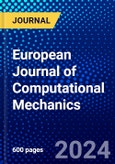- To publish research on original numerical methods and their application to the numerical simulation of engineering problems in solids, structures, materials and fluids. Contributions dealing with multi-physics or multi-scale problems are especially encouraged;
- To present innovative applications to complex engineering problems;
- To foster interactions between modelling approaches in different areas;
- To publish occasional review articles with a view to promoting an engineering application culture in computational mechanics.
Any article presenting new theoretical concepts is expected to also provide either numerical validations, comparisons with experiments, or applications to real-world engineering problems.
Submissions based on the straightforward application of classical approaches, e.g. using existing codes for performing parametric studies, are discouraged. All submitted manuscripts are subject to initial appraisal by the Editor, and, if found suitable for further consideration, to peer review by independent, anonymous expert referees. All peer review is single blind and submission is online.
Table of Contents
- Modeling and Simulation of Flow and Uranium Isotopes Separation in Gas Centrifuges Using Implicit Coupled Density-Based Solver in OpenFOAM
- Quasi-Isotropic Initial Triangulation of NURBS Surfaces
- Design Embodiments Using Squeeze-Film Phenomenon to Attain Complete Separation of Contacting Surfaces
- Cost-Effective Method of Optimization of Stacking Sequences in the Cylindrical Composite Shells Using Genetic Algorithm
- The Linear and Nonlinear Bending Analyses of Functionally Graded Carbon Nanotube-Reinforced Composite Plates Based on the Novel Four-Node Quadrilateral Element








